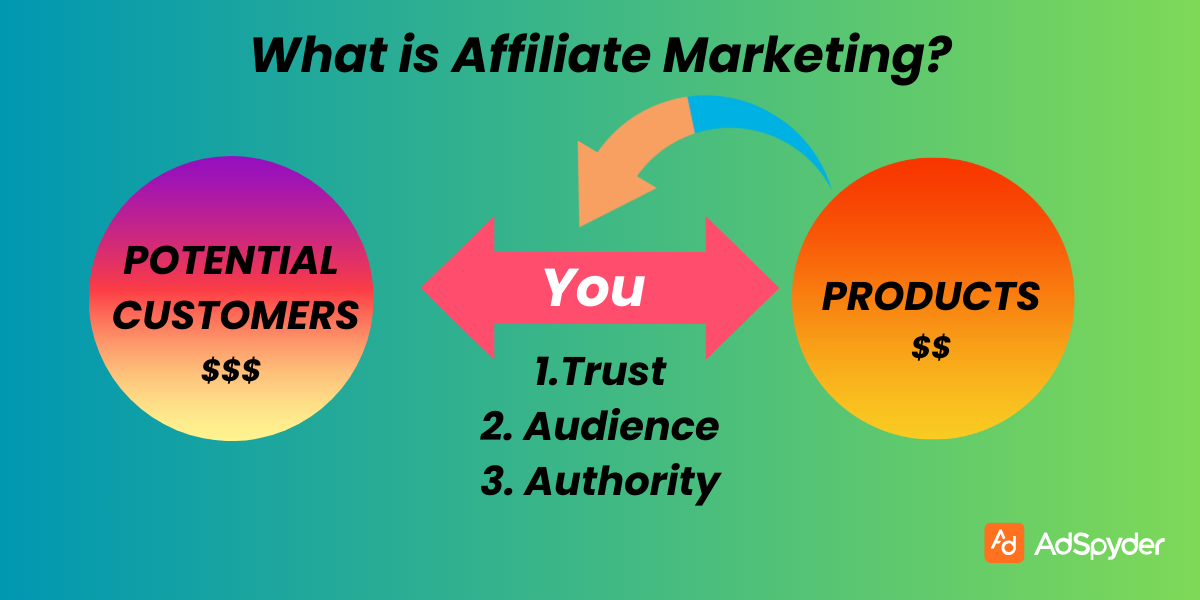Paid affiliate marketing strategies are essential for maximizing revenue and achieving success in the competitive world of online marketing. By carefully selecting the right niche, building a strong online presence, and creating high-quality content, you can drive more traffic and conversions. Leveraging data analytics, promoting through social media, and maintaining transparency with your audience are key components of an effective affiliate marketing plan. This blog explores ten proven tips to help you excel in paid affiliate marketing and stay ahead of the competition in 2024.
Core Principles of Affiliate Marketing

Affiliate marketing starts with a simple idea: you promote someone else’s products and earn a commission for each sale made through your links. It has grown into a key strategy in the digital advertising world, where partners work together to boost sales and share profits.
The Basics of Affiliate Marketing
- Affiliate marketing is about promoting products from others and earning a commission for every sale through your affiliate link. It’s a way to make money by sharing product details with your followers on social media platforms or your website.
- You pick products you like, promote them online, and earn a piece of the profit for each sale that comes through your link.
- To start with affiliate marketing, you first choose a niche or area of interest that matches what you’re passionate about. Then, you join affiliate programs where companies offer links for promoting their products.
- Use these links in your blog posts, emails, or social media to share with your audience. When someone clicks on one of these links and buys something, you get paid a portion of the sale price.
- This process is key in digital marketing strategies today because it benefits both content creators and businesses looking for more customers.
Evolution of Affiliate Marketing Programs
- Affiliate marketing has grown a lot over the years. It started simple: people shared links and got paid when someone bought something through those links.
- Now, it’s much bigger. Tools like Clickbank, Commission Junction, and ShareASale help people make more money by finding good products to promote.
- This change means affiliates can now pick from lots of options to match their audience.
- This growth also brought new strategies into play. People learned to use search engine optimization (SEO) and social media to reach more customers. They study trends and consumer behavior to find what works best.
- Using data helps them be more successful in promoting products and earning income through commissions. This way, affiliate marketing keeps changing as new tools and methods become popular.
Table: Paid Affiliate Marketing Strategies for 2024
| Strategy/Tool | Description | Keypoints |
|---|---|---|
| Strategy/Tool | Description | Key Points |
| Affiliate Program Selection | Choosing the right affiliate programs to maximize earnings. | – Look for trustworthy products. – High commission rates. – Relevant to your audience. – Use networks like Clickbank, Commission Junction, ShareASale. |
| CPA (Cost-Per-Action) Marketing | Focuses on earning commissions for specific actions taken by visitors through your affiliate links. | – Use high-converting offers. – Track performance with tools like Google Analytics. – Optimize ads and landing pages. – Write clear CTAs. |
| Paid Traffic Sources | Utilizing paid ads to increase visibility and drive targeted traffic to affiliate products. | – Platforms: Google Ads, Instagram, TikTok. – Test and optimize ads. – Track CTR and conversion rates. – Balance organic and paid strategies. |
| PPC (Pay-Per-Click) Campaigns | Crafting ads that pay per click to drive traffic to your affiliate products. | – Select the right keywords. – Link to high-quality content. – Track clicks to sales. – Use networks like Commission Junction. – A/B test ad elements. |
| Building Affiliate Relationships | Establishing and maintaining strong partnerships with affiliates. | – Clear communication. – Offer value and support. – Engage on multiple channels. – Track and tweak performance. – Provide useful content and tools. |
| Monitoring Performance | Using analytics to track and refine marketing strategies for better outcomes. | – Monitor CTR and conversion optimization. – Calculate ROI. – Use analytics tools to guide improvements. – Regularly adjust strategies based on performance data. |
| Compliance and Transparency | Following legal and ethical guidelines to build trust and maintain transparency in affiliate marketing. | – Disclose affiliate links. – Follow FTC guidelines. – Maintain honesty in promotions. – Use clear language. – Be transparent about commissions and benefits received from endorsements. |
| Staying Updated with Trends | Keeping up with emerging trends and adapting to changes in the affiliate marketing industry. | – Optimize for voice search. – Collaborate with influencers. – Continuously learn and adapt strategies. – Focus on high-quality products and high commission rates. – Engage actively with your audience. |
Check out: Dropshipping Business Plan | How to Start Dropshipping?
Choosing the Right Affiliate Marketing Programs

Picking the best affiliate marketing programs is key for earning more. Look at profit potential and the type of products to match your audience’s needs.
Criteria for Selecting Profitable Affiliate Programs
- Look for affiliate programs that offer products you trust and can recommend honestly. These products should be of good quality and relevant to your audience’s interests. High commission rates are also key.
- They make the effort worth it. Joining networks like Clickbank, Commission Junction, and ShareASale gives access to a variety of such programs.
- It’s essential to match the affiliate items with what your followers like or need. Doing this increases the chances they’ll buy through your links. Check each program’s reputation and read reviews from other marketers.
- This helps ensure you partner with reliable companies that pay on time and support their affiliates well.
Navigating Different Types of Affiliate Arrangements
- Different types of affiliate arrangements exist, like pay-per-sale and cost-per-action. Marketers must choose wisely to make money.
- Joining affiliate networks can help discover profitable products with high commission rates.
- Using keyword research tools enables effective product promotion.
- Email marketing is essential in reaching out to a target audience. It guides potential customers through the decision-making process. This approach increases the chances of converting leads into sales, boosting overall revenue from affiliate links.
Strategies for CPA (Cost-Per-Action) Marketing
To master CPA marketing, marketers focus on actions that lead to profit. They use tools like Google Analytics to track success and learn what works best.
Understanding CPA Marketing in Paid Affiliate Marketing Strategies
- CPA marketing stands for Cost-Per-Action marketing. In this type of affiliate marketing, marketers earn money every time someone takes a specific action through their affiliate link.
- This action could be signing up for a newsletter, downloading an app, or making a purchase. Marketers prefer CPA because it guarantees they only pay for actual outcomes, not just clicks or impressions.
- To succeed in CPA marketing, choosing high-converting offers is key. Look for products that match your audience’s interests and needs. Use performance-based marketing to promote these products effectively.
- Tools like Google Analytics play a crucial role here by tracking the success of your campaigns and helping you make informed decisions on what works best.
Tips for Maximizing Returns from CPA Campaigns
- Starting from understanding CPA marketing, it’s key to focus on how to make the most of these campaigns. Testing different advertisements and landing pages can show which ones work best.
- This lets you find the winning combinations that lead to more actions being taken by visitors, like signing up or making a purchase.
- Create ads that grab attention and write clear calls-to-action (CTAs). These steps encourage people to click through and complete the desired action. Track everything using analytics tools.
- This helps you see what’s working so you can invest more in those areas. Opt for products that are high quality and offer good money for your efforts. Keep optimizing your web pages to turn visits into earnings faster.
Leveraging Paid Traffic in Paid Affiliate Marketing Strategies
Using paid traffic helps affiliate marketers get more eyes on their products fast. They invest in ads on platforms like Google and social media to draw people in.
Identifying Effective Paid Traffic Sources
- Finding good sources of paid traffic plays a big role in affiliate marketing success. Good choices help super affiliates use their budget wisely and boost returns.
- Google Ads is one popular platform where affiliates can buy clicks to their sites.
- Social media sites like Instagram and TikTok also offer ad spaces for reaching specific audiences.
- By picking the right platforms, an affiliate marketer can drive more visits to promotional content or landing pages.
- Testing and optimizing ads are key steps after choosing traffic sources. Super affiliates experiment with different ad designs, messages, and target audiences to see what works best.
- They track click-through rates and conversion rates closely using tools like analytics programs. This approach helps them refine their strategies over time for better performance and higher earnings from their chosen niches.
Balancing Organic and Paid Traffic Strategies
- To achieve success in affiliate marketing, marketers must find the right mix of organic and paid traffic methods. Organic strategies call for creating engaging content and using SEO to draw people to your site naturally.
- This builds trust with your audience over time. On the other hand, paid strategies like social media ads or pay-per-click campaigns offer immediate visibility and can quickly drive targeted visitors to affiliate products.
- Mastering this balance is crucial. Marketers track their efforts closely, using analytics tools to see what works best. They adjust their tactics based on data-driven insights, ensuring they get a good return on investment from both organic and paid sources.
- This approach not only boosts credibility within the industry but also leads to higher commission rates from satisfied affiliates.
Pay-Per-Click (PPC) Advertising in Affiliate Marketing
In affiliate marketing, Pay-Per-Click (PPC) ads help marketers reach more people. They craft ads that link to products and pay a fee each time someone clicks.
Crafting Successful PPC Campaigns for Affiliate Products
- Crafting successful pay-per-click (PPC) campaigns for affiliate products starts with selecting the right keywords. Use tools like Google Trends to find what your target market is searching for.
- Then, create ads that match these searches. Your ads should link to high-quality content on your blog or website. This strategy will help increase your click-through rate and improve your return on investment.
- Next, track everything from clicks to sales using analytics software. This data tells you which parts of your campaign work well and which need tweaking. Adjust your keywords, ad copy, and landing pages based on this feedback to boost conversions further.
- Joining networks like Commission Junction can also provide valuable resources and support for optimizing your PPC campaigns.
Optimizing PPC Campaigns for Higher Conversions
- Using the right keywords boosts PPC campaign success. Focus on terms your audience searches for. This makes ads more relevant and can raise click-through rates (CTR). Tools like Google AdWords help find these keywords.
- Also, creating ads that match searcher intent increases chances people will click.
- Test different versions of your adverts to see which performs best. A/B testing modifies one element at a time, such as the headline or call to action. Analyzing results helps refine future campaigns for better conversion rates.
- Tools like Optimizely or Google Analytics provide insights into what changes improve performance. Keep adjusting based on feedback to continuously improve PPC conversions.
Using Paid Ads to Boost Paid Affiliate Marketing
Paid ads can take your affiliate marketing to new heights. They help you reach more people on platforms like Google Ads and Facebook Ads.
Selecting the Right Platforms for Paid Advertising
- Choosing the right platforms for your paid ads is key to successful affiliate marketing. You must consider where your target audience spends most of their time. Are they scrolling through social media, searching on Google, or watching videos on YouTube? Each platform has its strengths and suits different types of products differently.
- For example, Instagram works great for lifestyle and beauty items because you can show off these products in action.
- Creating ads that stand out requires understanding what each platform offers. Facebook allows for detailed targeting based on interests and behaviors, making it perfect for reaching specific groups.
- Google Ads can put your affiliate products in front of people actively searching related terms. This means your product shows up right when someone needs it. Match the platform’s special features with the kind of product you’re promoting to see better results from your advertising efforts.
Designing Effective Ad Campaigns for Affiliate Promotion
- Creating effective ad campaigns is key to success in affiliate marketing. Marketers should focus on crafting messages that provide value and resonate with their audience.
- This means understanding the target market’s needs and preferences, then highlighting how the promoted service or merchandise can meet those needs.
- Using attention-grabbing headlines, engaging visuals, and clear call-to-actions (CTAs) helps boost conversion rates. Testing different aspects of ads, such as layouts or headlines, allows marketers to find what works best.
- Next, identifying the right platforms for paid advertising plays a crucial role in reaching potential buyers where they are most active. Marketers should consider factors like platform demographics and costs versus potential return on investment (ROI).
- Social media channels, search engines, and niche websites often offer valuable opportunities for placing targeted ads.
- By optimizing campaigns based on performance data and continuously refining strategies, marketers can increase their effectiveness over time.
Must see: Enhancing Effectiveness: Ten Tips to Optimise Your Paid Pragmatic Marketing Strategies
Building and Nurturing Affiliate Relationships
Creating strong partnerships with affiliates is key. Use clear communication and support strategies to keep these relationships healthy.
Establishing Strong Partnerships with Affiliates
- Building strong partnerships with affiliates starts by picking the right niche. This choice attracts the best affiliates and sets the foundation for solid relationships. A strong brand pulls in quality partners, too.
- Offering value to your audience builds trust among your affiliate network. Use different promotion channels to attract various affiliates. This approach leads to diverse and robust partnerships.
- Engaging with affiliates boosts these relationships further. Always be honest and clear in your communication. Offer them useful content, tools, and support. Tracking performance and tweaking strategies show you’re committed to success together.
- Trust grows when both sides see improvement and profits rise. Strong partnerships thrive on mutual gains, open dialogue, and shared goals.
Communication and Support Strategies for Affiliate Networks
- Good communication is key in affiliate networks. Use social media platforms like TikTok and Instagram to share your message with a big audience.
- This helps you reach more people easily.
- To keep affiliates happy, offer them unique promo codes for their followers. This method makes it easy to track sales and rewards both the affiliate and customer.
Tracking and Analyzing Performance of Paid Affiliate Marketing Strategies
To succeed in affiliate marketing, you must follow how well your links and ads perform. Use tools like Google Analytics to see what works and change strategies if needed.
Key Metrics to Monitor in Affiliate Marketing
- Monitoring click-through rates (CTR) and conversion optimization are crucial in affiliate marketing. High CTR means many people see your ads or links and click on them. This is a sign that your messages capture attention.
- But clicks alone don’t lead to earnings. You need visitors to buy the products you promote.
- That’s where conversion optimization plays its part. It measures how well your traffic turns into sales or leads, showing if your strategy works.
- Keep an eye on return on investment (ROI) too. ROI shows how much money you make compared to what you spend on ads and promotions. It helps judge if your efforts in SEO optimization, social media management, and paid ads bring profits or losses.
- Tracking these metrics with analytics tools can guide improvements, making sure every dollar spent boosts performance-based marketing success.
Utilizing Analytics to Refine Affiliate Strategies
- Using analytics is key to understanding how well affiliate marketing strategies work. This approach helps marketers see which products and channels bring in the most money. By looking at data, they can figure out what changes to make for better results.
- Analytics tools give clear insights into each step of a marketing campaign, from click-through rates to sales conversions.
- Making decisions based on analytics leads to smarter moves in affiliate marketing. Marketers can spot trends, know which areas need improvement, and scale their efforts wisely. Data guides them in tweaking their tactics to match what their audience wants.
- This way, they enhance user experience and drive more sales effectively.
Legal and Ethical Considerations in Affiliate Marketing
In affiliate marketing, following the law and doing what’s right matters a lot. Marketers must know rules set by bodies like the Federal Trade Commission and always share the truth with their audience.
Adhering to Regulations and Best Practices
- Following rules and best practices in affiliate marketing is key. Marketers must keep their work honest and clear to build trust. This means always sharing the truth about which links are for earning money.
- Staying current with industry standards helps marketers choose profitable products and create content that draws people in. Using tools like search engine optimization makes websites easier to find, which brings more visitors.
- Writing great blog posts and using social media wisely can also attract a lot of attention. Successful affiliates focus on learning new things all the time to stay ahead.
Maintaining Transparency and Trust in Affiliate Marketing
- Keeping things open and honest is key in affiliate marketing. This means marketers should pick a niche they know well, build a strong brand identity, and produce high-quality content.
- Using clear language in promotional materials helps keep the audience informed. It also builds trust when marketers explain how affiliate links work.
- Sharing true stories about product experiences can make this even better.
- Strong relationships with both audiences and affiliates hinge on transparency too. Marketers must follow truth-in-advertising guidelines to stay on the right side of the law. Reveal any sales commissions or benefits received from links or endorsements clearly to readers or viewers.
- Trust grows when people feel they are getting honest recommendations rather than just being sold to.
Staying Ahead: Trends and Future of Affiliate Marketing
Emerging trends in affiliate marketing show a shift towards more personalized advertising strategies and the use of advanced analysis tools. To stay ahead, marketers must focus on keeping up with new technologies and adapting to changes in consumer behavior.
Emerging Trends in Affiliate Marketing
- Voice search is changing how people find products. Many use devices like smartphones and smart speakers for searches. Affiliates must optimize their content for voice queries to stay ahead.
- This means using natural, conversational language in SEO strategies.
- Influencers are becoming vital in affiliate marketing. They have loyal followers on platforms like Instagram and YouTube. Working with these influencers helps brands reach more customers.
- Their endorsements can boost sales and visibility for affiliate products.
Preparing for Future Shifts in the Affiliate Market
- To stay ahead in the affiliate marketing game, focus on choosing the right niche and building a strong brand. This strategy ensures you are ready for changes in the market. Promote only top-notch items that offer high commission rates to maximize your earnings.
- By committing to this approach, you position yourself well for whatever trends emerge.
- Engage actively with your followers by sharing valuable content and being open about your affiliate partnerships. This builds trust and strengthens your connection with them. Keep an eye on upcoming trends by continuously learning and adapting your strategies.
- Staying flexible lets you adjust quickly as the industry evolves, keeping you one step ahead of the competition.
Browse this: Google Ads For Dropshipping | The Complete Guide
Conclusion
Mastering paid affiliate marketing strategies opens doors to financial independence. Follow these ten powerful tips for success and watch your earnings grow. Choose profitable programs and use smart strategies for cost-per-action marketing.
Boost your sales with effective pay-per-click ads and leverage both organic and paid traffic wisely. Build strong relationships, track your progress, and always stay compliant with legal standards.
Keep learning about industry shifts to stay ahead. Success in affiliate marketing comes from dedication, smart choices, and continuous improvement.



